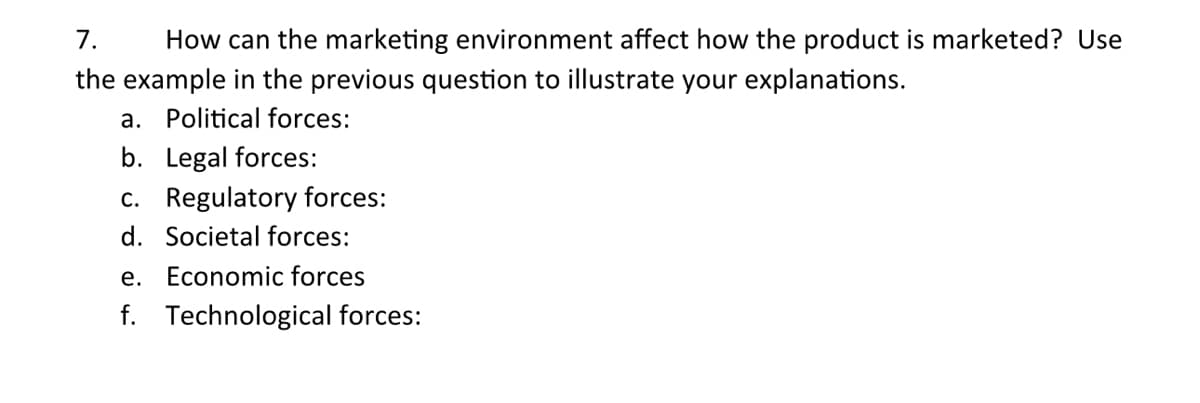6. Define the four components of a marketing mix. Use either non-commercial foodservice or nutritional services to illustrate your definition. a. Product: In the context of non-commercial foodservice or nutritional services, the product component refers to the actual food items or services offered to consumers. This could include the variety of menu options available, the quality and nutritional value of the food, as well as any additional services such as dietary counseling or meal planning provided by the foodservice establishment. b. Price:
6. Define the four components of a marketing mix. Use either non-commercial foodservice or nutritional services to illustrate your definition. a. Product: In the context of non-commercial foodservice or nutritional services, the product component refers to the actual food items or services offered to consumers. This could include the variety of menu options available, the quality and nutritional value of the food, as well as any additional services such as dietary counseling or meal planning provided by the foodservice establishment. b. Price:
Principles Of Marketing
17th Edition
ISBN:9780134492513
Author:Kotler, Philip, Armstrong, Gary (gary M.)
Publisher:Kotler, Philip, Armstrong, Gary (gary M.)
Chapter1: Marketing: Creating Customer Value And Engagement
Section: Chapter Questions
Problem 1.1DQ
Related questions
Question

Transcribed Image Text:6. Define the four components of a marketing mix. Use either non-commercial
foodservice or nutritional services to illustrate your definition.
a. Product:
In the context of non-commercial foodservice or nutritional services, the product
component refers to the actual food items or services offered to consumers. This
could include the variety of menu options available, the quality and nutritional
value of the food, as well as any additional services such as dietary counseling or
meal planning provided by the foodservice establishment.
b. Price:
Price in this context refers to the cost associated with the food or nutritional
services offered. This includes menu pricing for individual items or meal plans, as
well as any discounts, promotions, or pricing strategies implemented to attract
customers while ensuring profitability for the foodservice provider.
c. Promotion:
Promotion involves the communication and marketing efforts used to raise
awareness and attract customers to the non-commercial foodservice or
nutritional services. This can include advertising campaigns, social media
presence, collaborations with health organizations or influencers, as well as
promotional events or discounts to incentivize patronage and highlight the
benefits of the services offered.
d. Place:
Place refers to the distribution channels through which the non-commercial
foodservice or nutritional services are made available to consumers. This
includes physical locations such as dining facilities, cafeterias, or wellness centers
where the services are provided, as well as online platforms or delivery services
if applicable. The accessibility and convenience of these locations play a crucial
role in reaching the target audience and ensuring customer satisfaction.

Transcribed Image Text:7.
How can the marketing environment affect how the product is marketed? Use
the example in the previous question to illustrate your explanations.
a. Political forces:
b. Legal forces:
c. Regulatory forces:
d. Societal forces:
e. Economic forces
f. Technological forces:
Expert Solution
This question has been solved!
Explore an expertly crafted, step-by-step solution for a thorough understanding of key concepts.
This is a popular solution!
Trending now
This is a popular solution!
Step by step
Solved in 4 steps

Recommended textbooks for you

Principles Of Marketing
Marketing
ISBN:
9780134492513
Author:
Kotler, Philip, Armstrong, Gary (gary M.)
Publisher:
Pearson Higher Education,

Marketing
Marketing
ISBN:
9781259924040
Author:
Roger A. Kerin, Steven W. Hartley
Publisher:
McGraw-Hill Education

Foundations of Business (MindTap Course List)
Marketing
ISBN:
9781337386920
Author:
William M. Pride, Robert J. Hughes, Jack R. Kapoor
Publisher:
Cengage Learning

Principles Of Marketing
Marketing
ISBN:
9780134492513
Author:
Kotler, Philip, Armstrong, Gary (gary M.)
Publisher:
Pearson Higher Education,

Marketing
Marketing
ISBN:
9781259924040
Author:
Roger A. Kerin, Steven W. Hartley
Publisher:
McGraw-Hill Education

Foundations of Business (MindTap Course List)
Marketing
ISBN:
9781337386920
Author:
William M. Pride, Robert J. Hughes, Jack R. Kapoor
Publisher:
Cengage Learning

Marketing: An Introduction (13th Edition)
Marketing
ISBN:
9780134149530
Author:
Gary Armstrong, Philip Kotler
Publisher:
PEARSON


Contemporary Marketing
Marketing
ISBN:
9780357033777
Author:
Louis E. Boone, David L. Kurtz
Publisher:
Cengage Learning